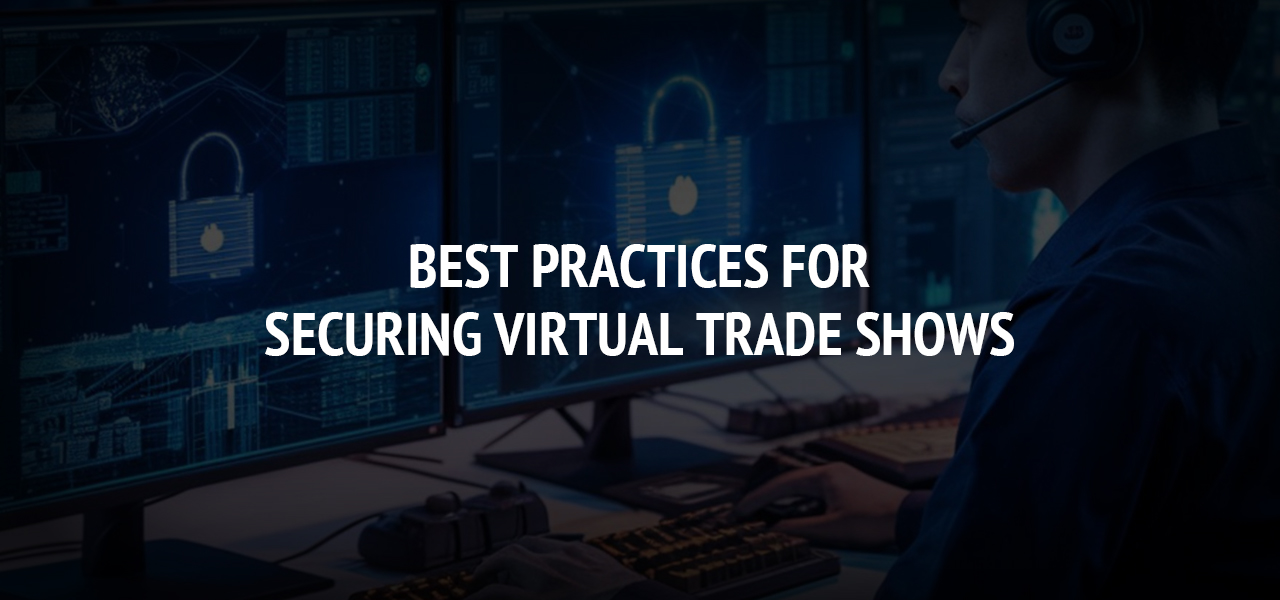Best Practices for Securing Virtual Trade Shows

As virtual trade shows become a vital part of modern business, ensuring their security is paramount.
Cyber threats, data breaches, and unauthorized access can jeopardize the success of these events, potentially exposing sensitive company and attendee information.
Implementing best practices for securing virtual trade shows helps to safeguard data, maintain trust, and ensure smooth operations. From choosing the right virtual event platform to enforcing access controls, encryption, and staff training, a comprehensive security strategy is essential.
This guide outlines the critical steps event organizers can take to protect their virtual trade shows from evolving cybersecurity threats.
Choose a Secure Virtual Event Platform
Choosing a secure virtual trade show platform is essential for safeguarding the safety and privacy of your participants and exhibitors. As cyber threats and data privacy concerns escalate, event organizers must prioritize platforms that provide robust security features.
Key elements to consider include encryption, which ensures data is protected both during transmission and storage; access controls, which restrict entry to authorized users only; and data privacy measures, which protect personal information in accordance with regulations like GDPR.
By opting for a virtual trade show platform that emphasizes these security features, you can create a safe and reliable experience for all involved.
Encryption:
Protecting Data in Transit and at Res Encryption ensures that sensitive information shared during a virtual trade show remains secure and confidential.
Platforms that offer end-to-end encryption protect data from interception during transmission and when stored on servers. This is crucial for safeguarding details like attendee information, business presentations, and payment transactions.
Look for platforms that use advanced encryption standards, such as AES (Advanced Encryption Standard) or TLS (Transport Layer Security), to provide robust protection. With encryption, both data in transit and at rest are shielded from unauthorized access, ensuring that participants' information remains private throughout the event.
Access Controls:
Access controls are essential for managing participant and exhibitor entry to the virtual event. A secure platform should provide features like password protection, two-factor authentication (2FA), and role-based access control (RBAC).
These measures prevent unauthorized users from entering the event and ensure that different users have appropriate permissions based on their roles. For example, exhibitors can access booths and presentations, while attendees may have limited access to certain areas.
Implementing strong access control mechanisms helps maintain the security of the virtual event, ensuring that only authorized individuals participate in key sessions and activities.
Data Privacy:
Data privacy is a critical concern for virtual events, particularly with the rise of global privacy regulations like GDPR. Platforms must ensure they handle personal and business data responsibly, from collection through storage and deletion. Look for platforms that offer secure data handling practices, including anonymization and clear consent mechanisms for participants.
Compliance with data protection regulations not only minimizes legal risks but also builds trust with attendees and exhibitors.
A privacy-focused platform ensures that sensitive information, such as personal details or financial transactions, is protected from misuse or unauthorized access, creating a secure and trustworthy event environment.
Implement Strong Access Controls
Implementing strong access controls is crucial for maintaining the security of virtual events.
By employing measures such as robust passwords, two-factor authentication (2FA), and role-based access, event organizers can ensure that only authorized individuals gain entry and have the appropriate level of access, thereby protecting sensitive information and preventing unauthorized access.
Passwords:
Establishing a Strong Defens Using strong, unique passwords is the first line of defense against unauthorized access. Ensure that all users—attendees, exhibitors, and organizers—create passwords that are complex and difficult to guess, incorporating a mix of letters, numbers, and symbols.
Platforms should enforce password policies requiring regular updates and prohibit easily guessable passwords. Additionally, consider implementing password strength meters to guide users in creating secure passwords.
Strong passwords significantly reduce the risk of unauthorized access and potential breaches, making them a fundamental component of effective access control in virtual events.
Two-Factor Authentication (2FA):
Two-factor authentication (2FA) provides an additional layer of security by requiring users to verify their identity through two different methods.
Typically, this involves something the user knows (a password) and something they have (a mobile device or authentication app). 2FA significantly enhances security by ensuring that even if a password is compromised, unauthorized access is still prevented.
Implementing 2FA for all critical access points within the virtual event platform helps protect sensitive areas, such as admin dashboards and exhibitor booths, from unauthorized entry, thereby enhancing overall event security.
Role-Based Access Control (RBAC):
Role-based access control (RBAC) allows for precise management of user permissions based on their roles within the virtual event.
Define specific roles—such as attendees, exhibitors, and organizers—and set access permissions accordingly. For instance, exhibitors should have access to their booths and presentation areas, while attendees should have restricted access to public sessions and networking features.
By assigning roles and permissions, you can ensure that each user accesses only the parts of the event relevant to their role, thereby minimizing the risk of unauthorized access and protecting sensitive content from exposure.
Real-Time Threat Monitoring
In the dynamic environment of virtual trade shows, real-time threat monitoring is essential for maintaining security and protecting against cyber threats.
As virtual events increasingly become targets for malicious activities, having a proactive approach to threat detection and response is crucial.
Real-time threat monitoring involves continuously observing and analyzing network traffic, user behavior, and system activities to identify potential security threats as they occur.
For virtual trade shows, this means keeping a vigilant eye on activities within the event platform, such as login attempts, file uploads, and data exchanges, to detect any anomalies or suspicious behavior.
Effective threat monitoring starts with employing robust security software designed for virtual environments.
This software should include features such as intrusion detection systems (IDS) and intrusion prevention systems (IPS) to identify and block potential threats in real-time.
These tools analyze patterns and behaviors to flag unusual activities, such as multiple failed login attempts or unauthorized data access attempts, and provide alerts to administrators.
Additionally, incorporating machine learning and artificial intelligence into threat monitoring can enhance detection capabilities. These technologies can learn from historical data to identify emerging threats and adapt to new attack methods.
They also enable faster response times by automating threat detection and response processes, reducing the window of opportunity for attackers.
Real-time threat monitoring should also involve regular updates and patches to the virtual event platform and its associated software.
Keeping systems up-to-date ensures that known vulnerabilities are patched, reducing the risk of exploitation.
In summary, real-time threat monitoring is a vital component of securing virtual trade shows.
By employing advanced security tools, leveraging AI and machine learning, and maintaining up-to-date systems, event organizers can effectively safeguard their virtual environments against cyber threats, ensuring a secure and smooth experience for all participants.
About The Author
Related Blog
View All-
Tips to Evaluate Mobile App development Company for your dream App
If you have a winning idea for a brand new mobile app which can potentially change the lives of the people as well as funding to make it actually happen, or even want an existing application which needs a major update, you need different things. You require a ...
-
How do Bingo Apps Qualify for the Google Play Store?
When setting up a bingo website, the site must be mobile-friendly, and the best way to engage with customers and gain popularity is to create a high-performing app that can be downloaded on the Google Play store. Google Play gets 8 billion new app installs per ...







